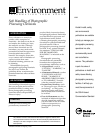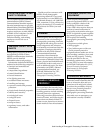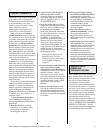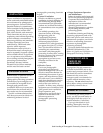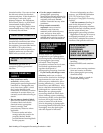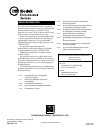
Safe Handling of Photographic Processing Chemicals • J-98A4
• Proper Equipment Operation
and Maintenance
Indoor air quality can be impacted
by how the processing equipment
is operated and maintained. It is
important to follow the
manufacturer’s recommended
operating procedures for
operating temperatures, agitation
of processing solutions, and
processing speeds.
In addition, draining and flushing
processing equipment tanks with
cold water prior to rack removal or
maintenance operations can also be
effective at controlling short-term
exposures to photographic
processing solutions.
For more detailed information see
KODAK Publication No. J-314,
Indoor Air Quality and Ventilation in
Photographic Processing Facilities.
Appropriate first-aid treatment is
included in the MSDS and on the
product and processor labels. First-
aid should be used for immediate
treatment in the event of an
emergency and is not intended to
replace medical attention, when
necessary. Do not administer first-
aid to others unless you have been
specifically trained to do so.
If a chemical gets into a person’s
eye(s), use the eyewash station to
thoroughly flush the eye(s). Get
medical attention, if necessary.
If you get chemicals on your
clothing, thoroughly rinse the
affected clothes to remove all of the
KNOW FIRST-AID IN
CASE OF AN
EMERGENCY
CHEMICAL SPLASHES
photographic processing chemicals
include:
• General Ventilation
Dilution ventilation or general
ventilation is simply bringing in
and distributing enough fresh
uncontaminated air (preferable
outdoor air) to dilute the indoor
air contaminants to an acceptable
level.
For minilab operations, the
American Society of Heating,
Refrigerating, and Air
Conditioning Engineers
(ASHRAE) recommends a
minimum general dilution
ventilation of 0.5 cubic feet minute
per square foot (cfm/ft
2
) of floor
area. This should be effective in
controlling air contaminants
associated with photographic
processing. In some cases, venting
the dryer section of the processor
to the outdoors may be
appropriate to prevent excess
humidity and odors in the
workplace.
• Effective Covers
Covers on photographic
processing equipment and
chemical storage tanks can be an
effective control mechanism for
minimizing the amount of gases,
vapors, and mists that may enter
the work area. Covers should be
made from durable non-reactive
materials and should cover as
much of the open surface as
possible. In many cases, effective
equipment covers combined with
good general room ventilation,
proper operation, and
maintenance may be all that is
needed to control odors and
airborne exposure to
photographic processing
chemicals.
Proper ventilation is important to
assure a safe and comfortable indoor
air environment for photographic
processing areas. Several common
potential indoor air contaminants
can be associated with photographic
processing. These include acetic
acid, sulfur dioxide, and ammonia.
These chemicals may be eye- and
respiratory-tract irritants depending
on their airborne concentrations.
Exposure guidelines and standards
for these chemicals have been
established by OSHA and other
agencies which represent
concentrations under which it is
believed that nearly all employees
may be repeatedly exposed without
adverse health effects. If significant
eye- or respiratory-tract irritation
occurs during normal photographic
processing or maintenance
operations, this may indicate
elevated levels of these materials
and the need for better control.
Kodak studies of potential worker
exposure during automated
photographic processing operations
indicate that vapors and gases can
be controlled to acceptable levels
through good general room
ventilation. However, in some cases,
local exhaust for enclosed and/or
open tanks may be recommended.
Specific recommendations that
have been proven to be effective in
minimizing airborne levels of
VENTILATION
EXPOSURE STUDIES



